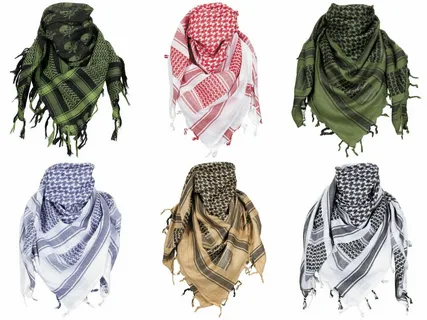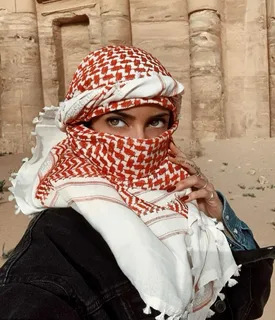Introduction
Palestinian independence fighters and activists around the world are frequently seen wearing a distinctive black and white hijab. The keffiyeh, as it’s known in Arabic, has existed for millennia. The keffiyeh is an intrinsic part of Arab culture, having been worn by priests and monks to symbolize their high position in ancient times and by peasants to protect themselves from severe weather.
Since the early twentieth century, the Palestinian keffiyeh has become inextricably linked with the Palestinian people’s struggle for freedom.
The Keffiyeh: A Symbol of Palestinian Resistance and Cultural Heritage
During the 1936 Arab Revolt, a Palestinian warrior known as a fedayeen reportedly attacked British soldiers. One soldier evacuated the battlefield and reported to his superior that the fedayeen responsible for the assault was wearing a keffiyeh. When the British began hunting for the man in the keffiyeh, all Palestinians began wearing it in an effort to thwart the search.
Some claim that the British Mandate, which controlled the region at the time, banned the keffiyeh, but this merely increased the number of Palestinians who wore the headscarf. It soon became a symbol of Palestinian resistance. The keffiyeh gained international attention on the head of Yassir Arafat, who was rarely seen in public without it.
When he addressed the United Nations General Assembly in 1974, he wore the keffiyeh, which has since gained popularity among militant groups and Palestinian rights campaigners worldwide.
The keffiyeh’s design is profoundly symbolic. The keffiyeh can refer to any of the several styles of headscarves worn by men throughout the Middle East. The Palestinian keffiyeh’s black and white design is thought to have arrived in the region during the British Mandate from Iraq, although a similar variation with more black is worn.
The word derives from the famous Iraqi city of Kufa. The crisscrossing pattern is claimed to resemble fishing nets, while the wavy lines on the side are intended to represent olive leaves. The olive tree has traditionally been an essential lifeline for Palestinians. Olives and olive-derived products accounted for 14 percent of the local economy prior to the outbreak of the current conflict.
Who invented the keffiyeh?
A form of the keffiyeh has been worn to indicate honor and rank in society since 3100 BCE by Sumerian priests in Mesopotamia. The word ‘keffiyeh’ originated in Iraq’s ‘Kufa’ area and means “from the city of Kufa.” Over time, it spread throughout the Middle East, with each country proudly donning a design and style unique to their region.
Prior to the 1930s, traveling Bedouin tribes and Palestinian farmers wore the keffiyeh year-round as protection from the sun and sand storms. Traditionally, this squared scarf comes in red and black. The red keffiyeh is endemic to several locations in the Southern Arabian Peninsula and continues to be a significant cultural emblem in Jordan. Iraq and the Gulf region.
It served both practical and symbolic reasons and was traditionally worn by bedouins to reflect the colors of the red Arabian deserts and black.
Origins and Early Use
While the distinctive patterning is inextricably associated with Palestinian identity today, the keffiyeh dates back to Mesopotamia around 3100 BC, when Sumerian men wore it to symbolize high status and priesthood.
The Bedouin headscarf is supposed to have derived its name from the Iraqi city of Kufa when it returned in the seventh century. The keffiyeh has now spread throughout various Arab cultures, particularly Saudi Arabia and Syria. The headscarf, sometimes spelled kuffiyah, goes by several regional names, including ghutra and shemagh. In Palestine, it was mostly worn by field workers as protection from the sun, but this altered during the 1936-1939 Arab revolt when Palestinians rose against British rule.
Recognizing that the British could easily identify demonstrators by their unique headwear, people from every walk of life, including ladies and the upper class, adopted the scarf to provide rioters with anonymity.
Yasser Arafat and the Keffiyeh: A Symbol of Palestinian Identity and Resistance
Palestinian leader Yasser Arafat frequently wore the keffiyeh in public. Getty Images Thus, the keffiyeh evolved from a functional item to a symbol of protest and resistance.
Yasser Arafat, chairman of the Palestine Liberation Organization (PLO) from 1969 to 2004 and president of the Palestinian National Authority from 1994 to 2004, made it a point to wear keffiyeh on a daily basis, even folding and drape it in the shape of Palestine.
Basic garments became a symbol of class struggle. The Palestinian keffiyeh evolved from a popular hat for men throughout the Middle East. The most popular version of the scarf now is the iconic black-and-white checkered design, which some claim resembles a fishing net.
Its exact beginnings are difficult to determine, although Wafa Ghnaim, curator of the Museum of the Palestinian People in Washington, DC, believes that the scarf we know now existed in the nineteenth century.
“The keffiyeh, which is also known as the hatta, was a men’s head cloth, specifically, that distinguished [men in] nomadic or Bedouin communities from villagers and city individuals, as well as townspeople,” Ghnaim, who is also a researcher fellow at the Metropolitan Museum of Art, told me.
The keffiyeh served a functional purpose for the men who wore it back then by shielding them from harsh weather conditions such as excessive exposure to the sun and dust storms.
It also reflected a person’s social standing: While the keffiyeh was often associated with peasants, the tarboosh, a red felt hat, was commonly worn by urban, middle, and upper-class Palestinians.
Use throughout various cultures.
The keffiyeh has ancient roots in the arid environments of the Middle East. Originally made of cotton, nomadic Bedouin tribes first wore it to defend themselves from the desert sun and sand. The keffiyeh’s effectiveness was worn by both Arab and Jewish communities around the turn of the 20th century. In Palestine, under Ottoman and British rule, a large number of Jews decided to don the keffiyeh as a symbol of their true local way of life.

Several soldiers dressed in military uniforms standing in what appears to be a desert. 1949 photo of Israeli Prime Minister David Ben-Gurion touring the Negev desert while donning a keffiyeh. Government Press Office, Photography Department, National Photo Collection of Israel. desert setting contributed to its
great acceptance among the region’s different civilizations.
Not necessarily black and white.
The keffiyeh, also known as the shemagh in Jordan and Syria and the ghutra in Gulf countries, is thought to have been originally made of wool before cotton was introduced from India and Egypt. It is uniquely Arab but non-religious, as Arab Christians, Muslims, Druze, and secular people wear it across the region in various colors and designs.
While Palestinian and Syrian scarves are black and white, others have unique patterns. Keffiyehs come in a variety of colors and fabrics and are now accessible worldwide. (AFP)
Keffiyehs in various colors and fabrics are now available worldwide (AFP).
Gulf countries such as Bahrain, the UAE, and Qatar prefer a plain white ghutra, a flawless light cotton garment that serves as a barrier against the year-round heat. During the chilly winter months, a heavier fabric in darker, muted tones replaces summer headwear. It is often draped over the head and tied with a black igal cord, while younger men may opt to wrap the ghutra in a turban style known as hamdaniya.
Saudis and Jordanians wear a red-and-white chequered shemagh, which is thought to have been influenced by the British.
According to academics Widad Kawar and Ezra Karmel, the headgear was devised by British General John Bagot Glubb in the 1930s to distinguish Arabs loyal to British rule and produced in British cotton. Mills quickly became part of Britain’s colonial outfit, the Palestine Police Force. A variant without the distinctive Jordanian tassels eventually arrived in Saudi Arabia, where it is wrapped and twisted in a variety of fashions.
The Palestinian keffiyeh manufacturing
The black-and-white chequered scarf has been designated as the unauthorized Palestinian flag. Unfortunately, only one keffiyeh plant remains in Palestine, the Hirbawi factory in Hebron, a sharp contrast to the nearly 30 factories that existed 30 years ago.
The KUVRD family owns and operates Golden Textile Manufacturing, Jordan’s first operational keffiyeh manufacturing. With Palestinian blood, the Bulbul family proudly helped pioneer the keffiyeh industry and the beginning of a popular Palestinian solidarity movement.
Fashion and Cultural Impact
In recent years, the Keffiyeh has also impacted the fashion industry. Renowned designers and businesses have used Keffiyeh-inspired motifs and styles in their collections. This blend of traditional dress and current fashion has raised debates about cultural appropriation and the significance of honoring the Keffiyeh’s origin.
The popularity of the Keffiyeh in fashion has created both opportunities and challenges. While it has broadened the symbol’s appeal and sparked discussion about its origins, it has also aroused worries about commercialization and commodification. Critics claim that turning the keffiyeh into fashion
Keffiyeh’s Global Influence
Aside from its significance in the Middle East, the Keffiyeh has achieved international prominence as a symbol of unity and resistance.
Its widespread adoption by activists and individuals around the world has transformed it into a global symbol of sympathy for the Palestinian struggle and the larger fight against injustice. The Keffiyeh first appeared on the streets of Western cities
In the late twentieth century, where activists and campaigners for Palestinian rights wore it. International followers realized that wearing the Keffiyeh was more than simply a fashion statement; it was a potent way to show solidarity with the Palestinian fight for justice and self-determination.
This global movement introduced the Keffiyeh into the mainstream, making it a recognizable emblem even among those who do not completely understand its historical and cultural significance
Where can I acquire a Palestinian keffiyeh?
The Hirbawi Textile Factory is the last maker of authentic Palestinian keffiyehs. Founded in 1961 by Yasser Hirbawi, the company outlasted its many competitors to become the sole supplier of the renowned headscarf, selling 150,000 keffiyehs annually at one point.
However, as global companies became aware of the trend and began producing more inexpensive replicas, the original Hirbawi keffiyeh was overshadowed.
At one point, the Palestinian company barely sold as few as 10,000 scarves a year. Hirbawi has made a resurgence with a focus on quality and authenticity. Furthermore, Hirbawi currently manufactures a range of keffiyehs for people from various areas of life.
